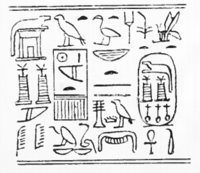Sobekneferu
Sobekneferu (sometimes written "Neferusobek") reigned as pharaoh of Egypt after the death of Amenemhat IV. She was the last ruler of the Twelfth Dynasty of Egypt and ruled Egypt for almost four years from 1806 to 1802 BC.[1] Her name means "the beauty of Sobek."
| Sobekneferu | |||||||||||||||||||||||||||||||||||||||||||||||||||||||||||||||||||||||||||||||||||||||||||||||||||||||
|---|---|---|---|---|---|---|---|---|---|---|---|---|---|---|---|---|---|---|---|---|---|---|---|---|---|---|---|---|---|---|---|---|---|---|---|---|---|---|---|---|---|---|---|---|---|---|---|---|---|---|---|---|---|---|---|---|---|---|---|---|---|---|---|---|---|---|---|---|---|---|---|---|---|---|---|---|---|---|---|---|---|---|---|---|---|---|---|---|---|---|---|---|---|---|---|---|---|---|---|---|---|---|---|
| Neferusobek Skemiophris (in Manetho) | |||||||||||||||||||||||||||||||||||||||||||||||||||||||||||||||||||||||||||||||||||||||||||||||||||||||
.jpg) Head of ruling pharaoh Sobekneferu | |||||||||||||||||||||||||||||||||||||||||||||||||||||||||||||||||||||||||||||||||||||||||||||||||||||||
| Pharaoh | |||||||||||||||||||||||||||||||||||||||||||||||||||||||||||||||||||||||||||||||||||||||||||||||||||||||
| Reign | 1806–1802 BC (Twelfth Dynasty) | ||||||||||||||||||||||||||||||||||||||||||||||||||||||||||||||||||||||||||||||||||||||||||||||||||||||
| Predecessor | Amenemhat IV | ||||||||||||||||||||||||||||||||||||||||||||||||||||||||||||||||||||||||||||||||||||||||||||||||||||||
| Successor | uncertain, Sekhemre Khutawy Sobekhotep[1] or, in older studies, Wegaf | ||||||||||||||||||||||||||||||||||||||||||||||||||||||||||||||||||||||||||||||||||||||||||||||||||||||
| |||||||||||||||||||||||||||||||||||||||||||||||||||||||||||||||||||||||||||||||||||||||||||||||||||||||
| Father | Amenemhat III | ||||||||||||||||||||||||||||||||||||||||||||||||||||||||||||||||||||||||||||||||||||||||||||||||||||||
| Died | 1802 BC | ||||||||||||||||||||||||||||||||||||||||||||||||||||||||||||||||||||||||||||||||||||||||||||||||||||||
| Burial | Northern Mazghuna pyramid (?) | ||||||||||||||||||||||||||||||||||||||||||||||||||||||||||||||||||||||||||||||||||||||||||||||||||||||
Family
She was the daughter of Pharaoh Amenemhat III. Manetho's Aegyptiaca states that she also was the sister of Amenemhat IV, but this claim is unproven; researchers have yet still to find proof. Sobekneferu had an older sister named Neferuptah, who was the intended heir. Neferuptah's name was enclosed in a cartouche and she had her own pyramid at Hawara. Neferuptah died at an early age, however, allowing Sobekneferu to be next in line. [2]
Reign
Sobekneferu was the first known woman reigning as pharaoh for which there is confirmed proof. There are women who are believed to have ruled as early as the First Dynasty, such as Neithhotep and Meritneith, but there is no definitive proof they ruled in their own right. Another candidate, Nitocris, would have ruled in the Sixth Dynasty; however, there is little proof of her historicity, and many scholars believe she is merely a legend deriving from a mistranslation of the pharaoh Neitiqerty Siptah's name.
Amenemhat IV most likely died without a male heir; consequently, Amenemhat III's daughter, Sobekneferu, assumed the throne. According to the Turin Canon, she ruled for three years, ten months, and 24 days[3] in the late 19th century BC.
She died without heirs/children, and the end of her reign concluded Egypt's Twelfth Dynasty and the Golden Age of the Middle Kingdom, which inaugurated the Thirteenth Dynasty.
Monuments and tomb


Few monuments have been discovered for her, although many of her (headless) statues have been preserved including the base of a representation of a king's royal daughter that was discovered in Gezer and bears her name.[5] One statue with a head is known. A bust in the Egyptian Museum of Berlin (Inv. no. 14476), lost in World War II, could be identified as belonging to her. Today, the sculpture is known only from photographic images and plaster casts. It came in 1899 to the museum. The head fits on top of the lower part of a royal statue discovered at Semna. The latter can definitely be identified as royal because the royal symbol "unification of the two countries" appears on the side of her throne.[6] It is known that she made additions to the funerary complex of Amenemhat III at Hawara (called a labyrinth by Herodotus) and also built structures at Heracleopolis Magna.
A fine cylinder seal bearing her name and royal titulary is located in the British Museum.[7] A Nile graffito, at the Nubian fortress of Kumma records the Nile inundation height of 1.83 meters in Year 3 of her reign.[8] Another inscription discovered in the Eastern Desert records "year 4, second month of the Season of the Emergence".[9] Her monumental works consistently associate her with Amenemhat III rather than Amenemhat IV, supporting the theory that she was the royal daughter of Amenemhat III and perhaps, only a stepsister of Amenemhat IV.[5] The Danish Egyptologist, Kim Ryholt, notes that the contemporary sources from her reign show that Sobekneferu never adopted the title of King's Sister-only "King's Daughter"-which supports this hypothesis.[5] Additionally, all Egyptian rulers were given the title "king", regardless of gender.
Her tomb has not been identified positively, although she may have been interred in a pyramid complex in Mazghuna that lacks inscriptions. It is immediately north of a similar complex ascribed to Amenemhat IV. A place called Sekhemneferu is mentioned in a papyrus found at Harageh. This just might be the name of her pyramid.
See also
References
- Ryholt, Kim S. B., The Political Situation in Egypt during the Second Intermediate Period, c.1800-1550 BCE, Museum Tusculanum Press, Carsten Niebuhr Institute Publications 20, Museum Tusculanum Press (1997), p. 185, ISBN 87-7289-421-0.
- Dodson, Hilton, The Complete Royal Families of Egypt, 2004, p. 98.
- Ryholt, The Political Situation in Egypt during the Second Intermediate Period (1997), p. 15.
- Petrie, Flinders: Scarabs and cylinders with names (1927), available copyright-free here, pl. XIV.
- Ryholt, p. 213.
- Fay, B., R. E. Freed, T. Schelper, F. Seyfried: "Neferusobek Project: Part I", in: G. Miniaci, W. Grajetzki: The World of Middle Kingdom Egypt (2000-1550 BC), Vol. I, London, 2015, ISBN 978-1906137434, pp. 89–91
- Callender, Gae, "The Middle Kingdom Renaissance", in Ian Shaw, The Oxford History of Ancient Egypt (Oxford University Press: 2003), paperback, p. 159.
- Callender (203), p. 159.
- Almásy, A., Catalogue of Inscriptions, in U. Luft (ed.), Bi'r Minayh, Report on the Survey 1998-2004, Budapest, 2011, ISBN 978-9639911116, pp. 174–175.
Bibliography
- Dodson, Aidan, and Dyan Hilton. 2004. The Complete Royal Families of Ancient Egypt, London: Thames & Hudson
- W. Grajetzki, The Middle Kingdom of Ancient Egypt: History, Archaeology and Society, London: Duckworth, 2006 ISBN 0-7156-3435-6, 61-63
- Shaw, Ian, and Paul Nicholson. 1995. The Dictionary of Ancient Egypt. Harry N. Abrams, Inc., Publishers.
- Shaw, Ian, ed. 2000. The Oxford History of Ancient Egypt, Oxford University Press. Graffito ref. p. 170.
